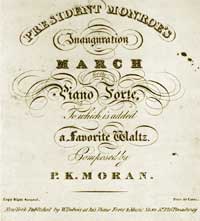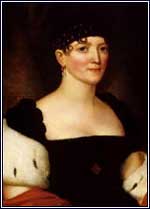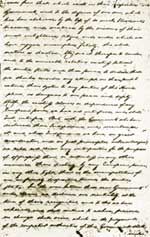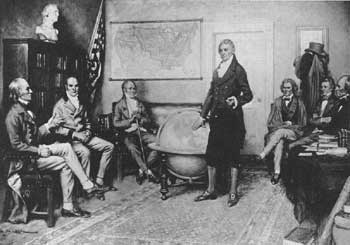






Biographical Sketches
|
JAMES MONROE Fifth President • 1817-25 |
 James Monroe | |
| ||
The son of a planter of modest means and the oldest of five children, Monroe was born in 1758 in Westmoreland County, Va. He received his elementary education at a private school. In 1776, some 2 years after his father died, he discontinued his studies at the College of William and Mary. He immediately entered active service in the Continental Army, which the year before had awarded him a lieutenant's commission. During 4 years of service he was wounded twice and advanced to the rank of major. Upon his discharge in 1780, he read law for 3 years with Thomas Jefferson, who became his lifelong adviser and friend.
 |
| March composed in honor of Monroe's inauguration. (Smithsonian Institution, Ralph E. Becker Collection.) |
Becoming active in politics, in 1782 Monroe entered the Virginia House of Delegates. The following year, he took a seat in the Continental Congress (1783-86). In 1786, when he joined the bar and established a practice in Fredericksburg, he married Elizabeth Kortright. She was to bear two daughters and a son.
Meantime, Monroe had been reelected to the House of Delegates (1786-90) and attended the Annapolis Convention, one of the forerunners of the Constitutional Convention. Nevertheless in 1788, indicative of his aversion to a strong central Government, he opposed the Constitution at the Virginia ratifying convention. That same year, James Madison soundly defeated him in a race for the U.S. House of Representatives.
 Elizabeth Monroe |
In 1790, when Monroe moved to Charlottesville, the Virginia legislature appointed him to the U.S. Senate (1790-94), where he became an advocate of Jeffersonian policies. Service as Minister to France (1794-96) and Governor of Virginia (1799-1802) followed. Reentering the diplomatic arena in 1803, he helped Robert R. Livingston negotiate the Louisiana Purchase from France and then held the position of Minister to Great Britain (1803-7), during which time he headed a special mission to Spain (1804).
In 1808, the year after Monroe returned to the United States, he temporarily lost Madison's friendship by vainly challenging him for the Presidency. In 1810 Monroe once again won election to the Virginia House of Delegates, and the following year also to the governorship. But, after only 3 months, he became Madison's Secretary of State (1811-17). In 1814-15 he was concurrently Secretary of War.
 |
| Monroe's seventh annual message to Congress, dated December 2, 1823. Page 30, reproduced above, outlines the Monroe Doctrine. The message was transcribed by a clerk and signed by Monroe. (National Archives.) |
Blessed by Madison and facing only slightly Federalist opposition, in 1816 Monroe was elected to the White House. The next year, only 2-1/2 months after taking office, he toured the Middle Atlantic States and then New England, the old Federalist stronghold. A Boston newspaper suggested that the warm welcome he received augured a political "Era of Good Feelings" in the Nation. But, despite his appointment of a competent intersectional Cabinet, the "good feelings" soon evaporated.
A depression struck the country in 1819 and, in a sudden emergence of the slavery issue, sectional debates broke out in Congress when Missouri sought admission to the Union as a slave State. The struggle captured headlines for 2 years and threatened to sunder the country. Disaster was averted by the Missouri Compromise (1820), which admitted Missouri as a slave State and Maine as a free State and outlawed slavery in the Louisiana Purchase area north and west of the southern boundary of Missouri.
In diplomacy Monroe achieved successes. The Rush-Bagot Agreement (1817) with Britain brought arms limitations on the Great Lakes. In the Adams-Onis Treaty, the United States acquired Florida from Spain, and Spain recognized United States claims to the Northwest as far as the Pacific shores. In addition, agreement was reached with Britain to the joint occupancy of Oregon and to delineation of the northern boundary of the Louisiana Purchase.
Monroe's greatest diplomatic accomplishment, however, was the Monroe Doctrine. Responding to the nationalistic revolutions that were freeing Latin America from Spanish and Portuguese control and fearing the intervention of various European powers, the British suggested a joint Anglo-American declaration that both nations would resist any intrusions in the area. Although Jefferson and Madison advised Monroe to accede to the British proposal, Secretary of State John Quincy Adams urged that the United States assert its independence by making its own declaration.
 |
| The President (at globe) formulates the Monroe Doctrine with his advisers. Secretary of State and the next Chief Executive John Quincy Adams (left) played a key role. (Oil, undated, by Clyde O. Deland, Philadelphia Board of Public Education.) |
| HISTORIC SITES & BUILDINGS |
 Oak Hill Monroe-Adams-Abbe House Monroe Tomb |
Monroe agreed and in his annual message to Congress in 1823, based on a draft prepared by Adams, he warned Europe against future colonization in the Western Hemisphere. This "Monroe Doctrine" was forgotten for many years, then revived by President James K. Polk at the time of the Mexican War (1846-48). By the late 19th century, the doctrine had become one of the cornerstones of U.S. foreign policy.
The years following Monroe's retirement to Oak Hill, Va., which he had completed in 1823, were filled with activity. He managed his estate, became a regent of the University of Virginia, served as cochairman of the State constitutional convention of 1829-30, acted as local magistrate, and even considered running again for Governor. But severe financial problems forced him to sell all his property, including his home, and in 1830 his wife died. He moved to New York City to live with one of his daughters. He died there, aged 73, on July 4 the following year.
 |
 |
http://www.cr.nps.gov/history/online_books/presidents/bio5.htm
Last Updated: 22-Jan-2004